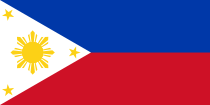Pagadian City
| Pagadian City Dakbayan sa Pagadian Lungsod ng Pagadian |
|||
|---|---|---|---|
| — City — | |||
|
|||
| Nickname(s): Little Hongkong of the South [1] | |||
| Motto: "Uswag Pagadian!" | |||
 |
|||
| Country | Philippines | ||
| Island | Mindanao | ||
| Region | Western Mindanao, Region IX (Capital) | ||
| Class | 2nd Class City[2] | ||
| Province | Zamboanga del Sur (Capital) | ||
| Barrios or Barangays | 54 | ||
| Highest Point | Mount Palpalan | ||
| Town Established | March 23, 1937 | ||
| City Established | June 6, 1952 | ||
| Government | |||
| - Type | City Legislative Council | ||
| - 1st District, Zamboanga del Sur | Rep. Victor Yu | ||
| - Mayor | Samuel S. Co (re-elect) | ||
| - Vice-mayor | Romeo Pulmones (re-elect) | ||
| Area | |||
| - City | 333.8 km2 (128.9 sq mi) | ||
| - Urban | 8.4548 km2 (3.3 sq mi) | ||
| - Metro | 325.34 km2 (125.6 sq mi) | ||
| Elevation | 100 m (328 ft) | ||
| Population (2007) | |||
| - City | 161,312 | ||
| - Demonym | Pagadianon | ||
| - Language(s) | Cebuano, Filipino, English, Ilonggo, Ilocano, Iranun, Maguindanao, Tausug, Samal, Chavacano | ||
| Time zone | PST (UTC+8) | ||
| ZIP Code[3] | 7016 | ||
| Area code(s) | +62 | ||
| Ecclesiastical Province | Archdiocese of Ozamiz | ||
| Episcopal Polity | Diocese of Pagadian | ||
| Patron Saint | Sto. Niño de Cebu | ||
| Diocesan Head | Bishop Emmanuel Treveno Cabajar, C.SS.R. | ||
| Website | http://www.pagadian.org | ||
Pagadian City(Subanen:Gembagel G'benwa P'hagadi-an/Bagbenwa P'hagadi-an) (Cebuano: Dakbayan sa Pagadian; Filipino: Lungsod ng Pagadian) is located in the province of Zamboanga del Sur, in the island of Mindanao. It is the regional government seat of Zamboanga Peninsula (Region 9) of the Republic of the Philippines.
An iconic symbol of Pagadian is its uniquely designed tricycle built to adopt to the city's hilly terrain. The locals claim with pride that it is the only place in the Philippines that one can see a public transport inclined at about 25-40° angle.[4][5][6]
Geography and Topography
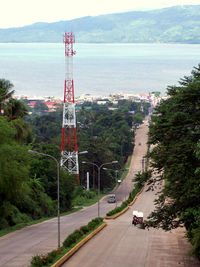
Situated on the northeastern side of the Western Mindanao region, Pagadian is the capital city of Zamboanga del Sur[7] province. It is bounded by the municipalities of Tigbao and Dumalinao on the southwest, Lakewood on the west, Labangan on the east and northwest, and Midsalip on the north.
About 45% of the total city area is steeply sloping terrain of hills and mountains on the northwestern portion that covers an estimated 15,090 hectares. Mt. Palpalan, Mt. Begong, Mt. Pinokis, and Mt. Sugar Loaf are the four tallest peaks. Areas in the direct north as well as the central part, have gentle to moderate slopes, making up 47% of the total. The remaining 8% is level or nearly level, and makes up most of the eastern and the southern parts of the city. The urban area covers about 845.48 hectares. Elevation of the urban area of the city ranges from 1 MSL (mean sea level) near Pagadian Bay to about 100 MSL in the area of Barangay San Jose.
The Tiguma, Bulatoc, Gatas, and Balangasan Rivers, drain to Pagadian Bay and serve as natural drainage.
Due to its topography and elevation, most of the city's 54 barangays do not experience flooding. The low-lying southern and eastern part of the city, though, do sometimes experience flooding, most especially during heavy rains.
Climate
It is located within the tropics of the northern hemisphere which has pronounced dry season from January to March and rainy season from April to December. The region is generally not affected by tropical storms and typhoons as it is located outside the Philippine Typhoon Belt. Temperatures range from 22.2 °C (72.0 °F) to 32.9 °C (91.2 °F). The prevailing winds are the southwest wind that blow shot gust wind from over the sea during dry seasons going northeast, and the trade winds brought about by the mountain range. Rainfall distribution is moderate from 2,500 mm to 3,000 mm annually.
History
Origin of the Name
The city proper and surrounding areas of Muricay, Tawagan Sur and White Beach was originally named "Talpokan," an indigenous word that means "a place of numerous springs".[8]
During the early part of the 20th century, the place was called "Pangad-ye-an", a Visayan word that means,"a place to be prayed for" due to a Malaria epidemic that nearly wiped out the early Christian population, majority of which came from the Visayas. An alternative theory suggests that it was named after a bird that the native inhabitants call "Gagadian". The officially accepted origin of its name are words taken from the Iranun dialect, "pagad" (wait) and "padian" (market)[8] which shows that Pagadian had been a trading or a barter area in the past.
Early Settlers
The native inhabitants in the area were the Subanens. Then came Moslem settlers who had converted the people to Islam. A sizeable number of those "lumads" who refused to be converted eventually settled in the highlands.
The early inhabitants were under the leadership of Datu Akob an Iranun Datu whose daughter caught the fancy of Datu Macaumbang also an Iranun (Sultan of Taga Nonok) from Malabang down to Tukuran up to Pagadian City. With the approval of Sultan Datu Akob, Datu Macaumbang married Bai Putri Panyawan Akob the former’ beautiful daughter of the Royal Datu of Pagadian City and Royal Bai Putri of Raya, at the same time Datu Mama Lapat Jamerol an Maranao-Iranon Datu who was the first cousin of Datu Macaumbang also married Bai Putri Concona Akob the second daughter of Royal Datu of Pagadian City and Royal Bai Putri of Raya. Upon the death of Datu Akob, his son-in-law, Datu Macaumbang (Sultan of taga Nonok) , assumed leadership then he established the territorial boundaries of the present city proper, from Balangasan River in the West of Tawagan Sur River in the East. Beyond the river of Tawagan Sur was the territory of Datu Balimbingan. At one time, Datu Macaumbang requested the assistance of the Philippine Constabulary due to the dreaded banditry and piracy. A detachment led by Col. Tiburcio Ballesteros stationed at Malangas landed at the place and stationed themselves at Dumagoc Island. The arrival of the soldiers restored peace and order thereby attracting the influx of settlers from far-flung regions of the Visayas and Luzon, and from the neighboring places of Mindanao.[9]
Spread of Christianity
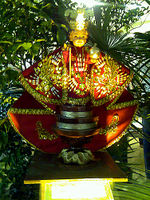
Christian settlers started arriving in the early part of the 20th century, most of which came from Cebu, as evident on the veneration of the Santo Niño de Cebú. The increasing Christian population prompted the creation of the Parish of Pagadian in 1938 and was administered jointly by the Jesuits, Columban and Filipino priests. The original Sto. Niño Church of Pagadian was right across the city plaza, built on the site where the San Jose Parish church now stands; Fr. Sean Nolan,SSC served as the first parish priest. The present Sto. Niño Cathedral is now located in Santiago District and was built in 1968.[10]
Pagadian Parish became a diocese on November 2, 1971 and is a suffragan of the Archdiocese of Ozamiz. Msgr. Jesus B. Tuquib served as the first bishop and was installed on February 24, 1973.[10] At that time, the Columban Fathers took care of the apostolic services for the first 13 parishes in the newly-formed diocese. They also took after the missions of the Jesuits.[10]
As of 2008, the Diocese of Pagadian has 24 parishes.[11]
The city celebrates its Annual Fiesta every 3rd Sunday of January in honor of its patron saint, the Holy Child Jesus (Sto. Niño) which also coincides with the feastday of Cebu City.
Timeline
| Date/Year | Significant Events |
|---|---|
| pre-1920s | The present-day Pagadian had its beginnings as a sitio of Margosatubig. |
| July 1927 | It became a barrio under the Municipal District of Labangan, Zamboanga upon the implementation of Executive Order no.70.[12] |
| 1934 | The transfer the seat of the Labangan Government to Pagadian was made through the efforts of Director Teofisto Guingona, Sr. who was commissioned by Philippine Governor-General Leonard Wood to find out the possibility of transferring the seat of government of the Labangan municipality to another place. A conference was first held, together with the Datus and the early Christian settlers as the idea of the transfer was at first largely opposed by the Christians. Eventually, a consensus was reached when the designated committee led by Datu Balimbingan of Labangan and with the consent of Datu Macaumbang surveyed the western part of the present area and found Talpokan, a part of the barrio of Pagadian, deemed as a suitable place for such transfer. At the same time, Datu Macaumbang donated 260 hectares of land to Christians who were willing to transfer to the area.[13] |
| March 23, 1937 | Pagadian became a municipality through Executive Order 77. Its ascendancy was due to the eager initiative of then Assemblyman Juan S. Alano, with the Hon. Jose Sanson appointed as Acting Mayor. A regular election was soon held with the Hon. Federico Jamisola elected as the first officially elected Municipal Mayor. The Municipality of Pagadian was formed by merging the municipal districts of Labangan and Dinas,[14] as a result, making Labangan a district under its former barrio. The newly created town had 19 barangays or districts.[15] |
| June 6, 1952 | Congressman Roseller T. Lim authored R.A. 711 dividing Zamboanga into two provinces - Norte (north) and Sur (south). |
| September 17, 1952 | Pagadian became the capital town of the newly established province of Zamboanga del Sur. |
| June 21, 1969 | It became a chartered city through R.A. 5478, becoming the third city in the Zamboanga Peninsula (Administrative Region). |
| August 16, 1976 | The city was one of the hardest hit areas in the Moro Gulf earthquake and tsunami of 1976, considered as the most devastating tsunami disaster in the Philippines in recent times.[16] Pagadian was the major city in the area that was struck by both the earthquake and tsunami and sustained the greatest number of casualties.[16][17] |
| October 1990 | President Corazon Aquino issued the Executive Order 429 that designated Pagadian City as the Center for Region 9.[18] |
| November 12, 2004 | After having waited for more than a decade, Pagadian officially became the Regional Center for Region IX- Zamboanga Peninsula[7] despite Zamboanga City government's opposition to the transfer.[19] |
Languages and Dialects
Majority of Pagadianons speak the Cebuano language (part of the Bisaya family of languages). The national language, Filipino (Tagalog) is widely understood and is the native tongue of a small percentage of the population. Iranun, Maguindanao, Maranao, Tausug, and Samal dialects are used by the Muslim community. The Subanen dialect is exclusively used by the Subanen people, the original inhabitants of the area. Remaining percentage of the population are classified as Ilonggo, Chavacano and Ilocano speakers. As in the case with the rest of the Philippines, English is understood by virtually everyone and is used as the primary language for business and official purposes.
Festivals
The city celebrates its fiesta every January, showcasing the Pasalamat Festival, fluvial parade (regatta), trade exhibits, the Mutya ng Pagadian beauty pageant, carnival shows as well as a civic military parade. On every 21 June, Pagadianons celebrate the Araw ng Pagadian in commemoration of its founding as a chartered city; and as Capital of Zamboanga del Sur, the city hosts the annual provincial celebration in September with agro-trade exhibits, a civic-military parade, cultural presentations and sports competitions.
The Megayon Festival is a week-long celebration that coincides with the Zamboanga del Sur anniversary in September. It honors the tri-people settlers: the Subanens, BangsaMoro Muslims and Christians.[20] "Megayon" is a Subanen tongue word which means Unity and Solidarity. The festival was officially established in August 3, 2006 as the celebration of the founding of the province through Provincial Ordinance No. 016-2006. A showcase of three distinctly different cultural heritage in songs, dances, rituals of peace, foods and crafts, its main goal is to foster unity and understanding among the three cultures. Organized environment-related activities, peace and development forum, and indigenous sports competitions[21] are also being held.
Pagadian City also officially celebrates the Chinese New Year. This was initiated by Mayor Samuel S. Co who assumed office in 2004. It honors the local Chinese community which had contributed significantly to the local economy.
Governance
Pagadian City belongs to the 1st District of Zamboanga del Sur. The local Sangguniang Panglungsod (City Legislative Council) is administered by the Mayor, with the assistance of the Vice-Mayor. It has ten elected councilors and one representative each from the Sangguniang Kabataan (Youth Council) and Association of Barangay Captains (ABC).
It is politically subdivided into 54 barangays of which 13 of these are classified as urban.
|
|
|
|
|
Economy
Industry
Agriculture is the primary economic resource, with the production of rice, corn, coconut, fruit and root crops. There are special programs like the Plant-now-Pay Later and Grains Production Enhancement Program that are made available for the local farmers; the City Livelihood Development Assistance Program (CILDAP) also extends loans to those who need financial assistance for their livelihood. Production of livestock such as hogs, goats, cows and poultry is also a growing local industry.
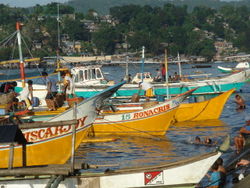
Pagadian Bay and the outer Illana Bay (Iranun Bay) abounds with a wide variety of fish species and crustaceans; seaweed culture farming is flourishing in waters off the bay while fishponds near or along the bay yields milkfish, prawns and crabs. A number of large deep-sea fishing vessels that venture into the Sulu Sea and farther off to South China Sea make Pagadian fishport their base of operation.
Another income-generating industry is mining. The mining area located 1.5 km southeast of Barangay Lison Valley proper approximately forty-nine kilometers from the city proper yields gold, copper and molybdenum.
Production of raw materials like seaweeds, coco processing, cassava constitute a large part of the local economy; small-scale manufacturing of furniture and decors made out of wood, bamboo, rattan, steel and plastic; handicrafts made out of bamboo, rattan, coco shell, wood, marine shell, ceramics, and weaving.
Banking
To date, there are eight (8) privately-owned, two (2) government-owned, five (6) rural banks, two(2) local thrift banks and one (1) cooperative bank in the city. The Philippines biggest banks- Metrobank, Banco de Oro and Philippine National Bank also serve the city.
|
|
Places to Stay, Shopping and Food
The move of the Regional Center[7] from Zamboanga City prompted a need for more hotels and pension houses in the city.
Hotel Alindahaw is arguably the premier hotel in the city. It is located just across Gaisano Mall. Pagadian Bay Plaza, Hotel Guillermo, Hotel Camila and the New Roxan Hotel are some of the more popular places to stay and Springland Hotel and Resort offers pools and restaurants aside from well-appointed rooms while JRC Grand Hotel and GV Hotel are two recently opened hotels in the city. Other hotels include Princess Hotel, The Peninsula Hotel, The Zamboanga Hotel, Pilgrims Hotel. Pension houses include Anastasia Pension House, Pensione de Yllana and Napsally's Pension.
Gaisano Capital Pagadian is the biggest mall in the city, recently opened in December 12, 2008. It is owned by the Gaisano Group of Companies. In terms of size, it is followed by Peoples Plaza, a department store owned by a Chinese local businessman. The Best Emporium Mall is owned by a Chinese family based in Zamboanga City. C3 Mall or City Commercial Center) which is currently under construction, is the site of the historic Shopping Center, where the old market, transportation terminal were once located. It would be the city's second biggest shopping center once finished by end of 2010. The Robinsons Department Store and Supermarket would be the major tenant of this 5-storey mall.[22]
Homegrown mid-size stores such as D'beam Hypermart, Unit City Central Pagadian, and Cariaga Hypermart are flourishing. These stores are the legacy of the local businessmen who had managed to build this city from its beginnings as a trading settlement to what it is now.
The Filipino-owned fast food chain Jollibee, is located in Pajares Avenue. Fine dining is available in Cafe Ilang-Ilang, Alindahaw Cafe and Guiller Cafe-Restaurant. Bialetti Caffe located beside Pagadian City Medical Center cater to the upper class with its European developed coffee-based concoctions. Greenhouse Fishing Station and Restaurant offers fresh seafood straight from its own fishponds that surrounds the place.
Tourist attractions
Pagadian City has a number of tourist attractions, though they are not as well-known throughout the Philippines.
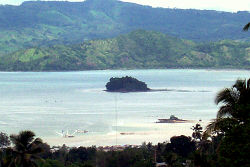
- Pagadian Rotonda - located on the upper reaches of Pagadian City overlooking Pagadian Bay, it is a circular park that intersects North Diversion Road and Pajares Avenue, two of the three major road networks in the city (the other one is Rizal Avenue). The Rotonda has maintained, landscaped gardens. There are horses for horseback-riding and a refreshment store.
- Dao Dao Islands - are two islands, Dako (big) and Gamay (small). The bigger island covers 1.10 hectares and is a 7-10 minute ride by motorboat from the seaport. It has artificial coral reefs; ideal for swimming, boating and fishing. Dao Dao Gamay is a sandbar and is partially submerged during high tide.
- Springland Resort - sourced from natural springs in the district of Tuburan. It has swimming pools and a fishpond. The resort also has a multifunction hall and a restaurant designed in Native Filipino Style.
- White Beach - a stretch of white sand beach just five minutes via motorboat southeast of the city seaport. Ideal for swimming and diving.
- Lourdes Waterfalls and Hot and Cold Springs - natural hot springs in barangay Lourdes, about 32 km. northwest from the urban area. This is tapped by the Pagadian City Water District as a piped water source for barangay Kagawasan.
- Lison Valley Waterfalls - located about 42 km. northwest of Pagadian proper, the falls has a height of about 20–25 meters. Its spherical-shaped basin, 20 meters in diameter, is ideal for picnic. Located in sitio Santa Lucia, about 18 km. from Lison Valley proper and is surrounded by giant ferns, orchids and mass-covered rocks. It overlooks ricefields and hills, and water discharge of the falls is 5 cu. m. per seconds.
- Manga Falls and Twin Caves - located in barangay Manga, just 7 km. from the city proper. This is a two-layered cascading fall, surrounded by huge trees that are home to white monkeys. The twin caves can be explored along the two-layered waterfalls. Currently in the process of being developed as a tourist spot.
- Mt. Palpalan - is the promontory within the Pagadian City limits on whose apex the transmitters of major commercial communication systems are built on. With a height of 684 ft above sea level, it has a sweeping vista of Pagadian City and Illana Bay.
- Mt. Susong Dalaga - which means "Maiden’s Breast". Located in barangay Lourdes, 32 km. from Pagadian proper and 10 km. from the barangay center, Susong Dalaga is a semi-perfect cone with good forest cover. It can be reached by horseback.
- Bulatoc Hill - Very accessible from the poblacion, being only 2.6 km away. Provides a view of Pagadian Bay. The hill used to be an island but is now linked to Pagadian through land reclamation. It offers a panoramic view of Pagadian Bay.
- Muricay Beach - Located in barangay Muricay, just a little over 4 km from the city proper, the white sand beach is available for swimming but is as yet undeveloped. Mangroce tracts and seaweed plantations are nearby.
- Bogo Hill - Situated at barangay Bogo, only 4 km from Pagadian proper. The hill is haven to agricultural land and offers a panoramic view of Pagadian Bay.
- Kendis Cave - About 14 km from Pagadian poblacion and 5 km from barangay Ditoray. Kendis Cave is an open-end cave with plants and vegetation. Has large overhead crevices with two interior chambers. Can be reached on horseback and currently under study.
- Dumagoc Hill - A former military reservation with contours following that of a heart. Still under study.
- Ditoray Waterfalls -This is 14 km from the Pagadian poblacion and 5 km from the center of barangay Ditoray. Large stones ring the falls.
- Mt. Pinokis - This one's in barangay Lison Valley, 42 km. from the Pagadian poblacion. Mt Pinokis is 2 km. from Mt. Susong Dalaga as 12 km. from barangay Lourdes. The mountain features virgin forests inhabited by native wildlife such as monkeys, birds, lizards as well as numerous species of reptiles, amphibians and insects. It can also be reached by horseback and is now under study for development.
- Agro-Tourism and Heritage Complex (AHC) – located a mere 5 minutes away from the center of Pagadian, the AHC has a Cultural Village, representing every town in Zamboanga del Sur, a Butterfly Park, and a Canopy Walk and Zipline.
Education
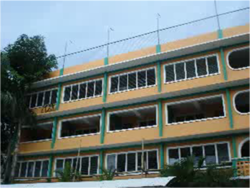
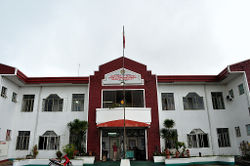
The Local Government Units (LGUs) supports the education sector through the Day Care Services (DCS) adopting Early Child Care & Development (ECCD) that provides early education for 3-5 year olds. These are established to make children better prepared for the higher levels of learning. The quality of DCS and the available resources vary widely across the geographical areas, with urban Day Care Centers (DCC) generally faring better than those in rural areas.[23]
Private
The two largest schools are Saint Columban College and Southern Mindanao high school. The former is the only private-Catholic tertiary school and largest in terms of assets while the latter is privately-owned and the biggest in terms of student population. Holy Child Academy, a private catholic institution and a sister school of St. Columban College, offers preschool and high school courses. The current demand and popularity of the Nursing and other medical courses also boosted the student population of Medina College Pagadian City and the Mendero College School of Nursing. The Zamboanga del Sur Maritime Institute of Technology is the only school in the city that offers Maritime and MassCom courses, among others; it is a branch of the Misamis Institute of Technology in Ozamis City. There are also a number of small to mid-size technical schools that offer mainly technology and vocational courses.
Public
A branch of the Western Mindanao State University External Studies is located within the expansive Zamboanga del Sur National High School compound. The Zamboanga del Sur School of Arts and Trade provides vocational, technical courses, and manpower development training. one national high schools serve the city: Zamboanga del Sur National High School, Pagadian City National Comprehension High School, and Lala National High School. Pagadian City Pilot School is the largest public elementary school in the city. Barangays Sta. Lucia, Balangasan, Sto. Niño, Bag-ong Silang, Camp Abelon and Lala also have public elementary schools to address the ever-increasing need for primary education.
Infrastructure
Transportation and Accessibility
Airport. The city is served by a secondary airport that can accommodate both commercial and private aircrafts. It is located in Barangay Muricay and Barangay Tiguma, five (5) kilometers from the city proper. It recently had undergone renovation and extension on its runway. As of present, Cebu Pacific is the only airline serving the city with flights to/from Cebu City and Manila. Beginning October 27, 2010 Cebu Pacific will fly 5 times a week Manila to Pagadian.
Seaport. The port of Pagadian City is served by seven (7) shipping lines operating for both passengers and cargoes. Ports of call include Zamboanga City, Jolo, Siasi, Bongao, Sitangkai and Cotabato City. The seaport is currently undergoing expansion and renovation.
Land Transportation/Road Network. The city has a road network with a total length of 374.07 km of which 311.02 km are barangay roads, 43.26 km are city roads, 5.98 km are city alleys and 13.80 km are national roads. A total of 235.22 km or 62.88% are concrete roads. The city has a total of 289.81 lineal meters of bridges/spillway/box culvert - 3 national bridges, 5 city bridges, 5 barangay bridges, 6 barangay spillways and 1 barangay box culvert.[24]
Four bus companies regularly serve the city for Zamboanga, Cagayan de Oro, Ozamiz and Dipolog while buses, minibuses and jeepneys are the means of transportation in the neighboring municipalities of Zamboanga del Sur. Tricycles are the primary transport in the urban center while jeepneys are the usual transportation for the city's rural barangays. Private vehicles constitute the greatest number of registered vehicles in the city.
Telecommunications
Itv-8 is a 24hour local information channel based in Pagadian. ABS-CBN Pagadian (DXLM-TV), TV-3 GMA, TV-11 NBN also have their private regional public broadcast service stations based in the city. The city is served by two cable companies: PCTV Cable and KISMET Cable. GMA inc.is planning its Qtv channel 26 after the closing of Studio 23 channel 24 in Pagadian City. The RPN was defuncted on 1990's.
- Radio Stations
- (AM)
- DXPR - Radio Mindanao Network (RMN)
- DXKP- Radio Philippines Network (RPN)
- DXID- Islamic Radio Station/Super Radyo DXID Pagadian 987 kHz 5 Watts
- DXBZ- Baganiang Broadcasting Corporation
- (FM)
| Frequency | Station Name | Call Sign | Company | Address |
|---|---|---|---|---|
| 91.1 MHz | V91 | DXKV | CBC | Balangasan, Pagadian City |
| 91.9 MHz | Radyo Natin | DXMD | MBC | Dumagoc, Pagadian City |
| 94.1 MHz | Radio1 | DXLN | MIT-RTVN inc. | Balangasan, Pagadian City |
| 96.7 MHz | iFM | DXWD | RMN | San Jose, Pagadian City |
| 99.9 MHz | Power 99 | DXWO | TBC | San Jose, Pagadian City |
| 106.3 MHz | Bell FM | DXCA | BBC | Sta. Maria, Pagadian City |
Utility
Telecommunications
Philippine Long Distance Telephone Company (PLDT) and Cruztelco are the two major telecommunications providers. A project under the Department of Transportation and Communications (DOTC), the Pagadian City Telephone Exchange (PACITELEX) serves the far-flung barangays that other telephone companies are not yet able to give service. The three major cellular phone service providers in the country such as Globe Telecom, Smart Communications, and Digitel/Sun Cellular also serves the city.
Water and Power Supply
Pagadian City Water District (PCWD) provides the city with potable water supply. Formed in 1976, the PCWD has over 14,000 active service connections and sources its water from deep wells and springs.[25]
Electricity is supplied by the Zamboanga del Sur Electric Cooperative, Incorporated (ZAMSURECO I) from the National Power Corporation Hydro-Electric Plant in Iligan City, sourced from the Maria Cristina Falls. About 77.70% or 42 barangays out of 54 total barangays in the entire city area have 24-hr electricity.
Health care
|
Notable People from Pagadian
- Enrique Ona - current Philippine Secretary of Health
- Gladys Dueñas - Miss Philippines-International 1995
Fast Facts
- The city was an awardee of the Cleanest and Greenest City in Western Mindanao consecutively, in CY 1998 and CY 1999.[26]
- Pagadian City hosted the 13th Asia-Pacific Youth Conference (APYC) in 2007. It is a project of the Initiatives of Change (IofC).[27][28]
- Pagadian is represented in the Liga Pilipinas by its own basketball team, the Pagadian Explorers.
- It is the home base of the Zamboanga del Sur - Pagadian FA, which is under the Philippine Football Federation.
- Teresa Magbanua, the Visayan Joan of Arc, died in Pagadian in 1947.[29]
Notes
- ↑ "Little Hongkong of the South". http://www.nscb.gov.ph/ru9/R9tourism/pag_facts.htm. Retrieved 2009-03-29.
- ↑ http://www.nscb.gov.ph/activestats/psgc/municipality.asp?muncode=097322000®code=09&provcode=73
- ↑ "Zip codes in the Philippines". http://zip-codes.philsite.net/pagadian.htm. Retrieved 2009-03-29.
- ↑ Only in the Philippines (retrieved: 31 March 2009)
- ↑ geomath.multiply.com (retrieved: 31 March 2009)
- ↑ My Pagadian.com(retrieved: 31 March 2009)
- ↑ 7.0 7.1 7.2 "Interactive Travel Guide on Pagadian City". iguide.travel – Pagadian City. 2009. http://iguide.travel/Pagadian. Retrieved 2009-04-26.
- ↑ 8.0 8.1 "Legend of Pagadian City". Pagadian.com. http://www.pagadian.com/legend.htm. Retrieved 2009-04-26.
- ↑ The Iranon Tribe Blogspot (retrieved: 29 March 2009)
- ↑ 10.0 10.1 10.2 "History of the Diocese of Pagadian - translated from Cebuano". Pagadian.com. http://pagadian.com/Diocese.htm. Retrieved 2009-04-26.
- ↑ [www.ucanews.com/../dps-pr_pagadian.php "Ucan Diocesan Profiles"]. UCA News. 2009-04-22. www.ucanews.com/../dps-pr_pagadian.php. Retrieved 2010-07-11.
- ↑ Labangan Teachers, p69. (retrieved: 29 March 2009)
- ↑ 1stphilippines.com - Pagadian History (retrieved: 29 March 2009)
- ↑ History of Zamboanga del Sur, p37-38 (retrieved: 29 March 2009)
- ↑ History of Zamboanga del Sur, p38 (retrieved: 29 March 2009)
- ↑ 16.0 16.1 "The Philippine Tsunami of 1976". www.drgeorgepc.com. http://www.drgeorgepc.com/Tsunami1976Phillipines.html. Retrieved 2009-04-26.
- ↑ Phivolcs Report, Earthquake of 1976(retrieved: 31 March 2009)
- ↑ Philippines Law Online (retrieved: 16 March 2009)
- ↑ Ipil News (retrieved: 31 March 2009)
- ↑ Unsapa.com - ZamboSur Anniversary (retrieved: 26 April 2009)
- ↑ PIA - Zamboanga del Sur (retrieved: 26 April 2009)
- ↑ http://www.skyscrapercity.com/showthread.php?p=54057981
- ↑ ZamboSur Education (retrieved: 29 April 2009)
- ↑ Pagadian City Socio-economic Profile (retrieved: 28 March 2009)
- ↑ Local Water Utilities Administration Website(retrieved: 28 March 2009)
- ↑ www.buyusa.gov - Pagadian Profile (retrieved: 13 February 2009)
- ↑ Unsapa.com News (retrieved: 13 February 2009)
- ↑ Pagadian.org News (retrieved: 13 February 2009)
- ↑ National Historical Institute (retrieved: 13 February 2009)
References
- Pagadian City Online Community
- Pagadian City FREE Local Classifieds
- Pagadian City Local News,Information, & City Guide
- Pagadian City Forum
- Pagadian City
- Philippine Standard Geographic Code
- 2000 Philippine Census Information
- The Leading Pagadian City News, Zamboanga del Sur News Website
- Zamboanga del Sur Communications (retrieved: 28 March 2009)
- Pagadian City Geography (retrieved: 28 March 2009)
- Pagadian's Website
- Basic Facts for Pagadian
- Local Accommodations
|
|||||||||||
|
|||||||||||
|
|||||||||||
